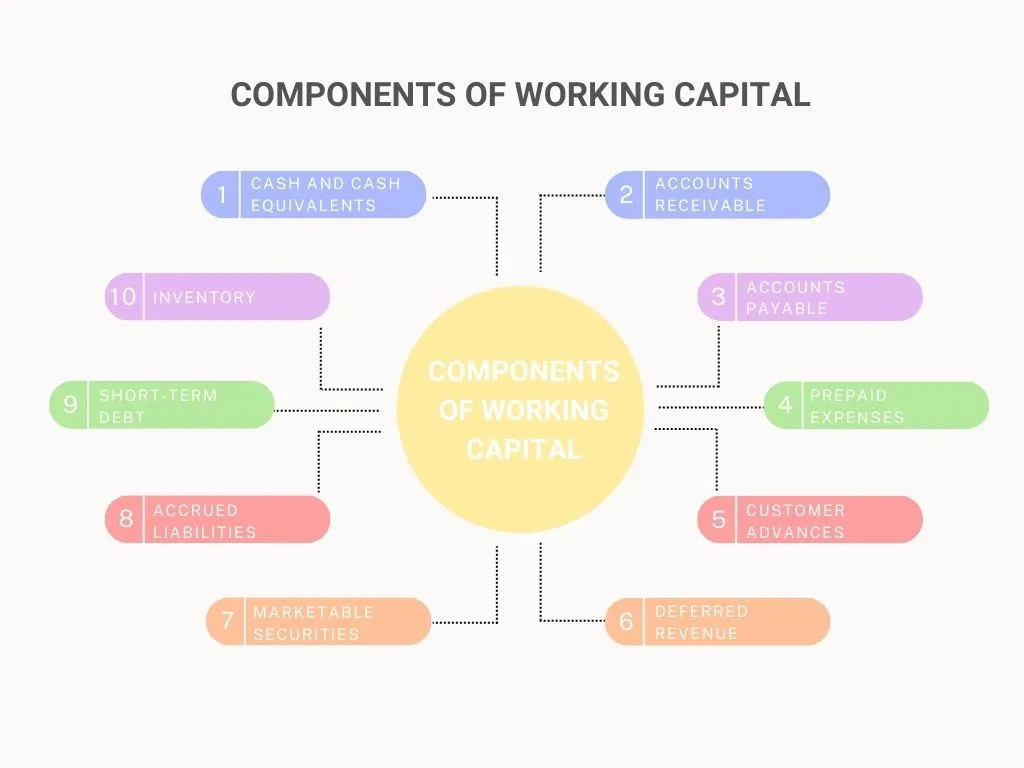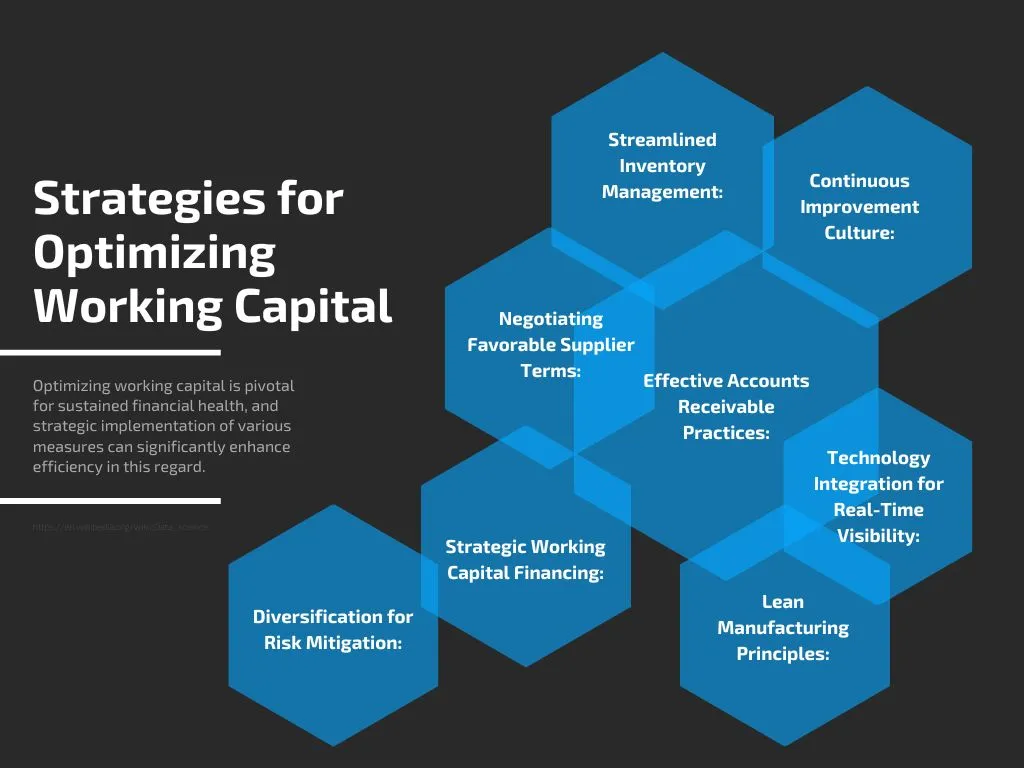- Definition of Working Capital
- Importance for Manufacturers
- Key Components of Working Capital
- Challenges in Managing Working Capital in Manufacturing
- Strategies for Optimizing Working Capital
- Successful Working Capital Optimization Stories
- Financial Tools for Working Capital Analysis
- Future Trends in Working Capital Management for Manufacturers
- Recap of Key Concepts
Definition of Working Capital
Working capital is a vital financial metric that reflects a company’s operational efficiency and short-term liquidity. It encompasses a firm’s current assets, such as cash, accounts receivable, and inventory, minus its current liabilities, including accounts payable and short-term debt. Optimizing working capital is the strategic management of these components to ensure a business maintains a balance between meeting its short-term obligations and maximizing operational potential.

Optimizing Working Capital enables organizations to minimize financing costs, enhance cash flow, and respond promptly to market dynamics. In essence, optimizing working capital is a key aspect of sound financial management, influencing a company’s ability to navigate economic uncertainties and sustain growth.
Importance for Manufacturers
Optimizing working capital is paramount for manufacturers as it directly impacts financial health and operational efficiency. Efficient inventory management ensures timely production without excessive stock, reducing carrying costs. Strong supplier relationships with favorable terms enhance cash flow. Streamlined production processes and technology adoption improve overall efficiency.
Effective accounts receivable management accelerates cash conversion while working capital financing provides liquidity for essential operations. Continuous improvement and risk management strategies safeguard against disruptions. Prioritizing working capital enables manufacturers to navigate economic challenges, seize growth opportunities, and maintain resilience in a dynamic market, fostering long-term sustainability and success.
Key Components of Working Capital
Cash and Cash Equivalents:
Cash on hand and short-term, highly liquid investments provide immediate financial resources for daily operations.
Accounts Receivable:
The amount owed by customers for goods or services delivered but not yet collected represents a crucial component, impacting cash flow.
Inventory:
The value of raw materials, work-in-progress, and finished goods affects production capabilities and ties up capital until sold.
Accounts Payable:
The amount a company owes to its suppliers for goods and services received but not yet paid influences short-term liabilities.
Short-Term Debt:
Loans and financial obligations due within the next year contribute to the overall working capital picture.
Prepaid Expenses:
Payments made in advance for goods or services, such as insurance or rent, impact future cash outflows.
Accrued Liabilities:
Unpaid expenses, like salaries and utilities, represent obligations that will impact working capital when settled.
Customer Advances:
Payments received in advance for goods or services signal future revenue but temporarily impact working capital.
Marketable Securities:
Short-term investments that can be quickly converted to cash contribute to a company’s overall liquidity.
Deferred Revenue:
Payments received for products or services not yet delivered create a liability until the obligation is fulfilled, affecting working capital.
Challenges in Managing Working Capital in Manufacturing
Fluctuating Demand and Supply Chains:
Optimizing Working Capital becomes intricate when faced with unpredictable shifts in market demand and supply chain disruptions, necessitating adaptable inventory management strategies.
Complex Production Cycles:
Manufacturers often contend with intricate production cycles, making it challenging to synchronize cash flows with the dynamic needs of raw materials, work-in-progress, and finished goods.
Dependence on Suppliers:
Reliance on external suppliers exposes manufacturers to risks such as price fluctuations and potential disruptions, impacting the ability to negotiate favorable terms and maintain optimal inventory levels.
Long Lead Times:
Extended lead times in manufacturing, from procurement to production, can tie up capital in inventory, affecting liquidity and the ability to respond swiftly to market changes.
Global Economic Volatility:
Manufacturers are susceptible to economic fluctuations, exchange rate variations, and geopolitical uncertainties, making it challenging to foresee and mitigate risks effectively.
Credit Risks and Payment Delays:
Balancing the need to extend credit to customers for competitive reasons while mitigating the risk of payment delays or bad debts is a delicate challenge.
Regulatory Compliance:
Navigating complex regulatory environments in different markets requires manufacturers to stay abreast of compliance requirements, adding a layer of complexity to working capital management.
Operational Inefficiencies:
Inefficient production processes, outdated systems, and lack of real-time visibility can hinder efforts to optimize working capital, affecting cash conversion cycles.
Resistance to Change:
Overcoming resistance to change within the organizational culture can impede the adoption of new technologies and efficient working capital management practices.
Strategies for Optimizing Working Capital
Optimizing working capital is pivotal for sustained financial health, and strategic implementation of various measures can significantly enhance efficiency in this regard.

Streamlined Inventory Management:
Efficiently managing inventory, aligning it with demand forecasts, and adopting just-in-time practices are crucial steps in optimizing working capital. By minimizing excess stock, companies can ensure liquidity and reduce carrying costs.
Negotiating Favorable Supplier Terms:
Establishing strong partnerships with suppliers and negotiating favorable payment terms is essential for optimizing working capital. Building collaborative relationships can result in extended payment terms and early payment discounts, positively impacting cash flow.
Effective Accounts Receivable Practices:
Implementing robust accounts receivable management processes, including timely invoicing and offering discounts for early payments, accelerates cash conversion cycles. This ensures a steady inflow of funds, optimizing working capital.
Technology Integration for Real-Time Visibility:
Leveraging advanced technology, such as integrated ERP systems and data analytics, provides real-time visibility into financial processes. This enhanced visibility allows for proactive decision-making, optimizing working capital by identifying and addressing inefficiencies promptly.
Top 6 Manufacturing accounting software – 2024
Strategic Working Capital Financing:
Exploring working capital financing options, including lines of credit and trade finance, can bridge short-term gaps and provide the necessary liquidity for operational needs. Securing cost-effective financing aligns to optimize working capital.
Lean Manufacturing Principles:
Adopting lean manufacturing principles helps eliminate waste, reduce lead times, and enhance overall production efficiency. This streamlined approach optimizes resource utilization, contributing to working capital efficiency.
Continuous Improvement Culture:
Fostering a culture of continuous improvement ensures that the organization regularly evaluates and refines working capital management strategies. This proactive approach helps adapt to changing market conditions, optimizing working capital over the long term.
Diversification for Risk Mitigation:
Diversifying supplier and customer bases minimizes dependency on a single source, reducing the impact of disruptions. This risk mitigation strategy contributes to the overall resilience and optimization of working capital.
By systematically integrating these strategies into their operational framework, companies can enhance liquidity, improve cash flow, and achieve the overarching goal of optimizing working capital. This multifaceted approach ensures adaptability to market dynamics and positions businesses for sustained financial success.
Successful Working Capital Optimization Stories
Several companies have demonstrated successful working capital optimization, achieving remarkable financial health. Through streamlined inventory management and negotiation of favorable supplier terms, these organizations enhanced their liquidity. By implementing advanced technology for real-time visibility and embracing a continuous improvement culture, they optimized working capital, reducing inefficiencies.
Strategic working capital financing and adherence to lean manufacturing principles further contributed to their success. These stories highlight the transformative impact of optimizing working capital, emphasizing its crucial role in achieving financial resilience and sustained growth.
Financial Tools for Working Capital Analysis
Optimizing working capital necessitates a comprehensive analysis, and several financial tools are instrumental in gaining insights into key metrics.
Cash Flow Statements:
These statements provide a detailed overview of cash inflows and outflows, helping identify trends and potential liquidity issues. Regular analysis aids in optimizing working capital by ensuring a healthy cash position.
Days Sales Outstanding (DSO):
DSO measures the average number of days it takes to collect receivables. Reducing DSO through efficient accounts receivable practices is crucial for optimizing working capital and ensuring a faster cash conversion cycle.
Inventory Turnover Ratios:
Calculating inventory turnover ratios gauges how efficiently a company manages its inventory. A higher ratio signifies optimized working capital as goods move quickly through the production cycle.
Payables Days:
This metric evaluates the average time it takes for a company to pay its suppliers. Extending payables days strategically contributes to optimizing working capital by preserving cash.
Working Capital Ratios:
Ratios like the current ratio (current assets divided by current liabilities) and the quick ratio (quick assets divided by current liabilities) provide an overall view of a company’s liquidity and its ability to meet short-term obligations, contributing to working capital optimization.
Cash Conversion Cycle (CCC):
CCC measures the time it takes for cash to cycle from payment to suppliers through to cash collection from customers. Reducing the CCC is a key goal in optimizing working capital, ensuring a streamlined cash flow process.
Financial Forecasting Tools:
Leveraging forecasting tools helps predict future cash flows and working capital needs. This proactive approach enables companies to optimize working capital by adjusting strategies based on anticipated financial requirements.
Enterprise Resource Planning (ERP) Systems:
Advanced ERP systems integrate various business processes, providing real-time visibility into financial activities. This technology enhances decision-making for optimizing working capital by identifying and addressing inefficiencies promptly.
Future Trends in Working Capital Management for Manufacturers

Automation and Artificial Intelligence (AI):
Automation and AI technologies are increasingly being integrated into working capital management processes. Automated invoicing, AI-driven demand forecasting, and smart analytics contribute to optimizing working capital by enhancing efficiency and accuracy.
Blockchain Technology:
Blockchain’s decentralized ledger system offers transparency and security in transactions. In supply chain finance, blockchain can optimize working capital by reducing fraud risks, improving trust among parties, and streamlining payment processes.
Data Analytics for Predictive Insights:
Enhanced data analytics tools provide manufacturers with predictive insights into market trends, customer behavior, and supply chain dynamics. Leveraging such analytics enables proactive decision-making, optimizing working capital based on future scenarios.
Supply Chain Digitization:
The digitization of supply chains facilitates real-time visibility and collaboration. Manufacturers can optimize working capital by minimizing disruptions, reducing lead times, and enhancing overall supply chain efficiency.
Dynamic Discounting:
Dynamic discounting platforms allow manufacturers to offer flexible payment terms to suppliers, optimizing working capital by incentivizing early payments and strengthening supplier relationships.
Sustainable Practices:
Sustainable and eco-friendly initiatives are becoming integral to working capital strategies. Adopting environmentally conscious practices can optimize working capital by reducing waste, lowering costs, and meeting consumer demands for sustainable products.
Robotic Process Automation (RPA):
RPA streamlines routine tasks, such as invoice processing and order fulfillment, contributing to working capital optimization by reducing operational costs and enhancing accuracy.
Integrated Financial Ecosystems:
Manufacturers are moving towards integrated financial ecosystems that connect various stakeholders. This connectivity optimizes working capital by facilitating seamless transactions, collaboration, and information sharing.
Recap of Key Concepts
Working capital, defined as current assets minus liabilities, is pivotal for operational efficiency. Strategies for optimizing working capital include streamlined inventory management, favorable supplier negotiations, and advanced technology integration. Real-life success stories underscore the transformative impact of optimized working capital.
Financial tools such as cash flow statements and ratios aid in thorough analysis. Future trends foresee the integration of blockchain, AI, and sustainable practices in reshaping working capital management for manufacturers, ensuring resilience and growth.

